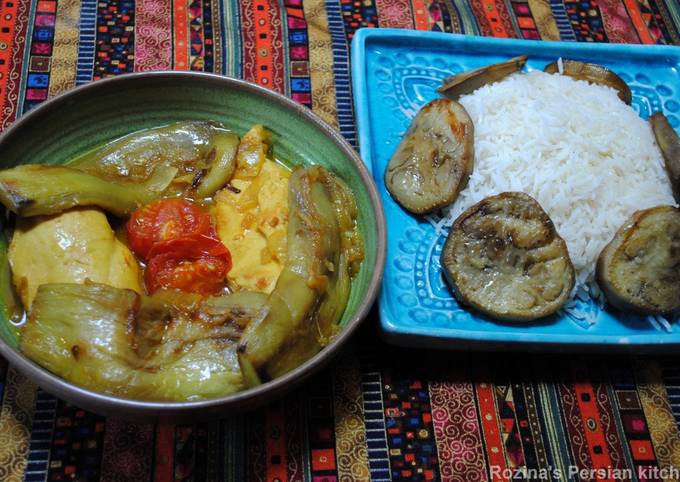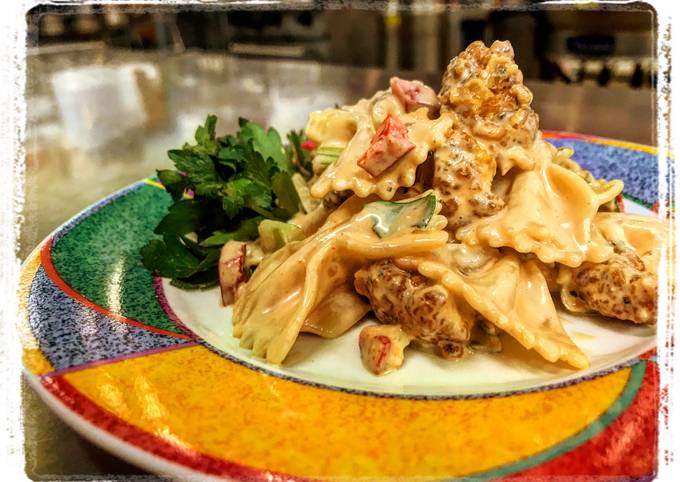
Hey everyone, it is me again, Dan, welcome to our recipe site. Today, I’m gonna show you how to make a distinctive dish, persian eggplants stew with chicken. One of my favorites. For mine, I will make it a bit tasty. This is gonna smell and look delicious.
Arrange the partially cooked eggplants on top of the stew and gently press them down to submerge them into the stew. A Persian stew made with chicken, Japanese eggplant, and sour grapes. This Khoresh Bademjan is one of my mom's staples that I grew up with, and I'm excited to share it with you. "Khoresh" translates to "Stew" and "Bademjan" translates to "Eggplant." In a pot with water, add one of chopped onion, garlic and chicken. Leave it to cook. if there is leftover chicken juice add it to the stew afterwards.
Persian Eggplants Stew with Chicken is one of the most popular of recent trending meals on earth. It’s enjoyed by millions every day. It is easy, it’s quick, it tastes yummy. They are nice and they look fantastic. Persian Eggplants Stew with Chicken is something which I’ve loved my whole life.
To begin with this particular recipe, we have to prepare a few ingredients. You can cook persian eggplants stew with chicken using 9 ingredients and 18 steps. Here is how you cook that.
The ingredients needed to make Persian Eggplants Stew with Chicken:
- Get 2 eggplants
- Take 2 onions cut into lengthwise and fry
- Prepare 2 cloves garlic
- Prepare 2 chicken breast or legs (but you can choose beef or lamb meat as well)
- Make ready 1-2 medium size tomatoes cut into half
- Take to taste Salt-red chilli powder
- Prepare 1 Tbsp saffron water (if not available use turmeric)
- Prepare 1 tbsp lemon or lime juice
- Make ready Vegetable oil
Serve with Basmati Rice and Lavash bread for dipping into the sauce. In Iran, Khoresht Bademjan made with beef, lamb, or chicken is a traditional eggplant stew enjoyed at many dinner tables. Sometimes a new recipe can seem overwhelming, especially if it is from a culture unfamiliar to the cook. However, this dish is simple to make and uses basic ingredients which helps you to put an impressive authentic Persian meal on the table in about an hour and a half.
Instructions to make Persian Eggplants Stew with Chicken:
- Peel skin off egg plants. Cut into lengthwise or circle shapes. Put some salt on cut eggplants to excess moisture and the bitterness. By this way, eggplants will fry faster and would not soak too much oil.
- Before frying the eggplants wrap the eggplants in a kitchen towel and pressing which removes all salty water.
- Fry the eggplants until both sides are nicely golden.
- Fry other chopped onion. Then fry the cooked chicken breasts for 3-4 minutes..
- In a pot with water, add one of chopped onion, garlic and chicken. Leave it to cook. if there is leftover chicken juice add it to the stew afterwards.
- Now in a pot with fried chicken, add eggplants, fried onions, spices,tomatoes, saffron water, lemon juice. Add leftover chicken juice and cook for 20 minutes over a low heat. - Once your delicious eggplant stew is ready, serve it with rice or flat bread. Enjoy it
- Here i have made eggplant stew with beef.
- Ingredients
- Ingredients
Sometimes a new recipe can seem overwhelming, especially if it is from a culture unfamiliar to the cook. However, this dish is simple to make and uses basic ingredients which helps you to put an impressive authentic Persian meal on the table in about an hour and a half. Arrange chicken in a single layer in the pot; cover with some of the tomato mixture. Khoresh Bademjan or Bademjoon is a Persian Eggplant Stew with meltingly soft eggplants in a thick and tangy tomato based sauce, with pieces of meat to make it heartier. This stew is made with main ingredients being eggplant, tomatoes and spices.
So that is going to wrap it up with this special food persian eggplants stew with chicken recipe. Thanks so much for your time. I’m sure you will make this at home. There is gonna be interesting food in home recipes coming up. Remember to bookmark this page in your browser, and share it to your family, friends and colleague. Thank you for reading. Go on get cooking!

